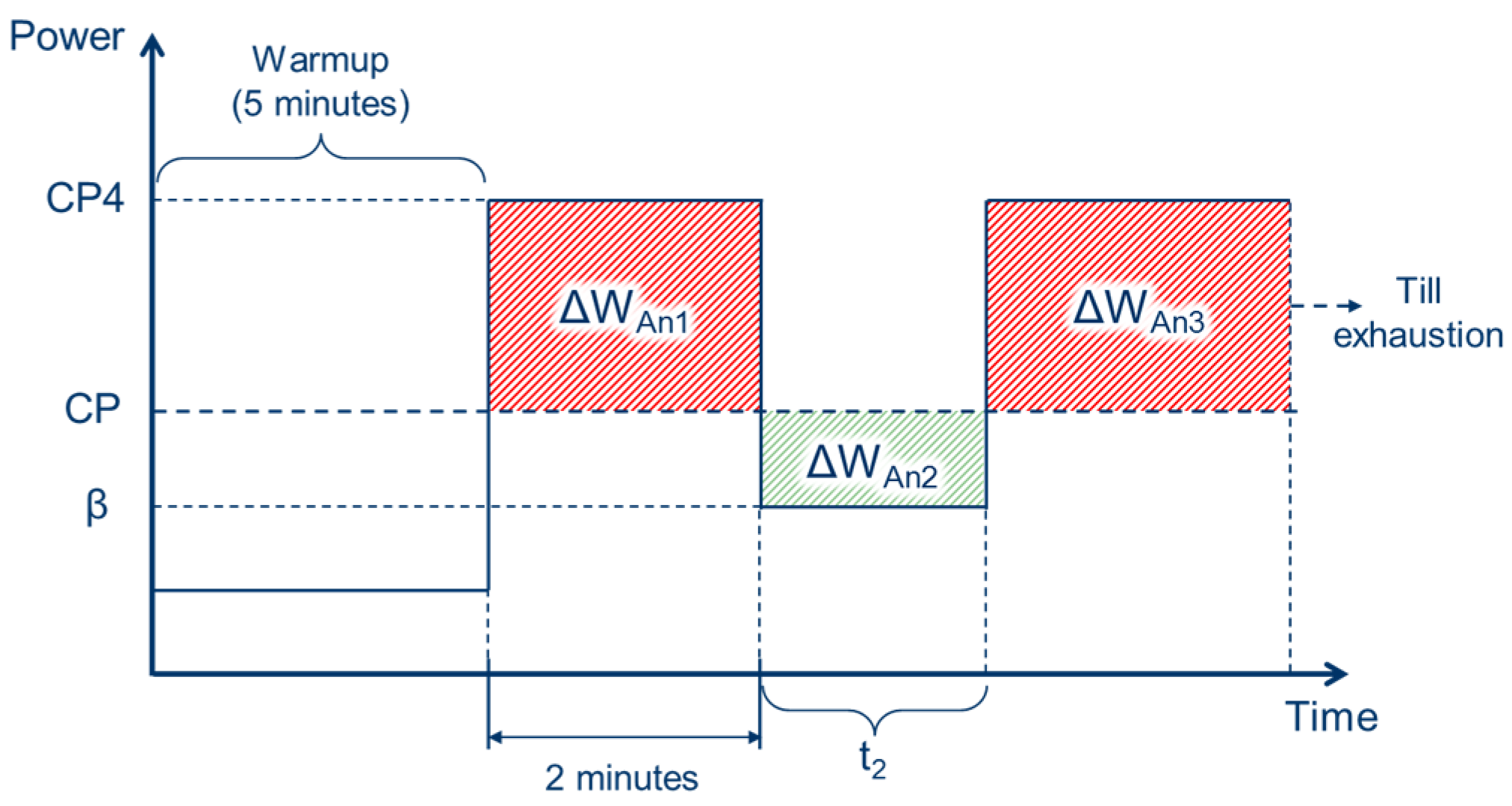Modeling the Expenditure and Recovery of Anaerobic Work Capacity in Cycling †
Abstract
:1. Introduction
2. A Review of Anaerobic Work Capacity and Critical Power
3. Hypothesized Model of Recovery and Expenditure
4. Materials and Methods
4.1. Participants
4.2. Equipment and Data Collection
4.3. Experimental Design for Determining Phi, Φ
4.4. Determining Critical Power and Anaerobic Work Capacity
5. Results and Discussions
6. Conclusions and Future Work
Acknowledgments
Conflicts of Interest
References
- Monod, H.; Scherrer, J. The Work Capacity of a Synergic Muscular Group. J. Ergon. 1965, 8, 329–338. [Google Scholar] [CrossRef]
- Someya, T.; Bao, Z.; Malliaras, G.G. The rise of plastic bioelectronics. Nature 2016, 540, 379–385. [Google Scholar] [CrossRef] [PubMed]
- Hill, A.V. The Physiological Basis of Athletic Records. Nature 1925, 116, 544–548. [Google Scholar] [CrossRef]
- Hill, D.W. The criticial power concept. Sports Med. 1993, 16, 237–254. [Google Scholar] [CrossRef] [PubMed]
- Gaesser, G.A.; Carnevale, T.J.; Garfinkel, A.; Walter, D.O.; Womack, C.J. Estimation of critical power with nonlinear and linear models. Med. Sci. Sports Exerc. 1995, 27, 1430–1438. [Google Scholar] [CrossRef] [PubMed]
- Housh, D.J.; Housh, T.J.; Bauge, S.M. A methodological consideration for the determination of critical power and anaerobic work capacity. Res. Q. Exerc. Sport 1990, 61, 406–409. [Google Scholar] [CrossRef] [PubMed]
- Morton, R.H. Critical power test for ramp exercise. Eur. J. Appl. Physiol. Occup. Physiol. 1994, 69, 435–438. [Google Scholar] [CrossRef] [PubMed]
- Morton, R.H.; Green, S.; Bishop, D.; Jenkins, D.G. Ramp and constant power trials produce equivalent critical power estimates. Med. Sci. Sports Exerc. 1997, 29, 833–836. [Google Scholar] [CrossRef] [PubMed]
- Vanhatalo, A.; Doust, J.H.; Burnley, M. Determination of critical power using a 3-min all-out cycling test. Med. Sci. Sports Exerc. 2007, 39, 548–555. [Google Scholar] [CrossRef] [PubMed]
- Clark, I.E.; Murray, S.R.; Pettitt, R.W. Alternative Procedures for the Three-Minute All-Out Exercise Test. J. Strength Cond. Res. 2013, 27, 2104–2112. [Google Scholar] [CrossRef] [PubMed]
- Vanhatalo, A.; Doust, J.H.; Burnley, M. Robustness of a 3 min all-out cycling test to manipulations of power profile and cadence in humans. Exp. Physiol. 2008, 93, 383–390. [Google Scholar] [CrossRef] [PubMed]
- Johnson, T.M.; Sexton, P.J.; Placek, A.M.; Murray, S.R.; Pettitt, R.W. Reliability analysis of the 3-min all-out exercise test for cycle ergometry. Med. Sci. Sports Exerc. 2011, 43, 2375–2380. [Google Scholar] [CrossRef] [PubMed]
- Morton, R.H.; Billat, L.V. The critical power model for intermittent exercise. Eur. J. Appl. Physiol. 2004, 91, 303–307. [Google Scholar] [CrossRef] [PubMed]
- Ferguson, C.; Rossiter, H.B.; Whipp, B.J.; Cathcart, A.J.; Murgatroyd, S.R.; Ward, S.A. Effect of recovery duration from prior exhaustive exercise on the parameters of the power-duration relationship. J. Appl. Physiol. 2010, 108, 866–874. [Google Scholar] [CrossRef] [PubMed]
- Skiba, P.F.; Chidnok, W.; Vanhatalo, A.; Jones, A.M. Modeling the Expenditure and Reconstitution of Work Capacity above Critical Power. Med. Sci. Sports Exerc. 2012, 44, 1526–1532. [Google Scholar] [CrossRef] [PubMed]
- Skiba, P.F.; Clarke, D.; Vanhatalo, A.; Jones, A.M. Validation of a novel intermittent w’model for cycling using field data. Int. J. Sports Physiol. Perform. 2014, 9, 900–904. [Google Scholar] [CrossRef] [PubMed]
- Clark, I.E.; Gartner, H.E.; Williams, J.L.; Pettitt, R.W. Validity of the 3-Minute All-Out Exercise Test on the CompuTrainer. J. Strength Cond. Res. 2016, 30, 825–829. [Google Scholar] [CrossRef] [PubMed]
- Chidnok, W.; Dimenna, F.J.; Bailey, S.J.; Vanhatalo, A.; Morton, R.H.; Wilkerson, D.P.; Jones, A.M. Exercise tolerance in intermittent cycling: Application of the critical power concept. Med. Sci. Sports Exerc. 2012, 44, 966–976. [Google Scholar] [CrossRef] [PubMed]

| Group 1 | Group 2 | ||
|---|---|---|---|
| Subject | Critical Power (W) (Mean ± SD) | Subject | Critical Power (W) (Mean ± SD) |
| C7 | 187 ± 5.6 | C11 | 160 ± 13.6 |
| C4 | 236 ± 6.6 | C2 | 119 ± 14.7 |
| C1 | 165 ± 8.2 | C12 | 102 ± 23.8 |
| C8 | 236 ± 10.8 | C3 | 135 ± 17.7 |
| C10 | 186 ± 11.5 | ||
| Average | 202 ± 8.5 | 129 ± 17.5 | |
Publisher’s Note: MDPI stays neutral with regard to jurisdictional claims in published maps and institutional affiliations. |
© 2018 by the authors. Licensee MDPI, Basel, Switzerland. This article is an open access article distributed under the terms and conditions of the Creative Commons Attribution (CC BY) license (https://creativecommons.org/licenses/by/4.0/).
Share and Cite
Bickford, P.; Sreedhara, V.S.M.; Mocko, G.M.; Vahidi, A.; Hutchison, R.E. Modeling the Expenditure and Recovery of Anaerobic Work Capacity in Cycling. Proceedings 2018, 2, 219. https://doi.org/10.3390/proceedings2060219
Bickford P, Sreedhara VSM, Mocko GM, Vahidi A, Hutchison RE. Modeling the Expenditure and Recovery of Anaerobic Work Capacity in Cycling. Proceedings. 2018; 2(6):219. https://doi.org/10.3390/proceedings2060219
Chicago/Turabian StyleBickford, Phoebe, Vijay Sarthy M. Sreedhara, Gregory M. Mocko, Ardalan Vahidi, and Randolph E. Hutchison. 2018. "Modeling the Expenditure and Recovery of Anaerobic Work Capacity in Cycling" Proceedings 2, no. 6: 219. https://doi.org/10.3390/proceedings2060219





